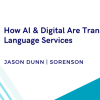Business process outsourcing saves companies significant time and money, enabling them to focus on their core business activities. And nowhere is this more impactful than in the document processing arena. Billions of pages of documents move between companies, their partners/suppliers and customers each year.
For example, as of 2019, organizations around the world receive 550 billion invoices annually, which need to be processed and have data extracted and entered in the correct system of record for further processing.
Traditionally, organizations have relied on a combination of outdated, legacy technology and manual data entry to extract and key the information by hand. This process is slow, expensive and error-prone, and it has cost organizations over $60 billion each year. Beyond that, it impacts the entire customer lifecycle. Inefficiencies in back-office operations can cause a data- and decision-making bottleneck that makes it challenging to respond to client needs in a timely fashion.
For these reasons, business process outsourcing (BPO) has been an attractive solution for many companies. Yet, if outsource providers use the same manual processes or legacy systems as companies do, they are faced with the same problems, which gets compounded in today’s business environment.
Unexpected times of crisis, such as the current global pandemic, have upended current operating models, causing a large portion of the workforce – including data entry staff and knowledge workers – to shift to remote work. With manual document processing stretched to the limit and remote work enduring for the foreseeable future, there is an accelerated push for digital transformation across virtually every industry, including business process outsourcing.
Unexpected and Unprecedented Challenges
It has become clear during the pandemic that our current system for outsourcing business processes is vulnerable. BPOs, along with organizations everywhere, have been dealing with the effects of work-from-home protocols, including the well-documented technological struggles people experienced in trying to get enough Internet bandwidth to support processing from home.
According to a poll conducted by Asana, more than half of knowledge workers did not have a dedicated desk, laptop or reliable Internet connection to easily make the shift to remote work. And that was just in the U.S. Countries like India or the Philippines, where many outsourcing services for Fortune 500 companies are located, have been facing steep technology challenges and bandwidth limitations.
At the same time, BPOs have struggled to find a solution for protecting sensitive customer information when data is being processed remotely, especially since many companies have contracts that prohibit sensitive customer information from being processed on personal computers. This has hindered the ability to fully support customer requests during a quarantine.
Business Demands Require Flexible, Intelligent Solutions
As the world continues to shift, BPOs increasingly need to turn to intelligent automation – as well as business preparedness and continuity plans – to overcome these challenges. Forward-thinking BPO providers that had already invested in emerging technologies were able to establish the necessary infrastructure to support remote work, keep operations running and reduce disruption to customers.
Based on market need, document processing and data entry is a crucial priority for BPO automation, and it can benefit from advanced artificial intelligence (AI) and machine learning (ML) technologies – today and into the future. Some companies are turning to Robotic Process Automation (RPA) to automate manual work, but its value is limited to rules-based processes that have structured data inputs.
While this works well for simple tasks, such as copying data from a spreadsheet or dragging and dropping files into a folder, it is not suited for processing more complex tasks and data inputs. This includes the diverse, unstructured data typically found in handwritten forms, electronically-generated PDFs, images and other documents. ML can address this need through continuous learning capabilities that enable the solution to improve based on the data that it receives.
How Technology Streamlines the BPO Process
When turning to automation, it’s essential for BPOs to evaluate their goals so they can select the right technology to accomplish them. Whether that’s handling a greater volume of documents with the same resources, speeding up processing time, increasing accuracy or all three, the evaluation stage is crucial.
In addition, make sure the solution can easily be integrated with other systems, has the flexibility and scalability to adapt to future requirements, and stringent security capabilities to keep personal data secure.
While technology is a vital part of the solution, it’s also important to figure out how people fit into the process. Automated solutions can process documents faster, but humans are often needed to provide additional context to resolve edge cases or other hard-to-read data. They should play a supervisory role to ensure the system is performing against goals.
The next months will be critical for many organizations as they regroup, address upcoming challenges and prepare for the future. The agility offered by automation can help bridge processing gaps, mitigate risks and help customers get the assistance they need.
By turning to intelligent automation, outsource providers can process documents with a high degree of accuracy and speed, resulting in increased efficiencies and cost savings. This pivot provides a critical competitive advantage in all business climates.






